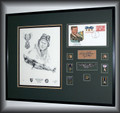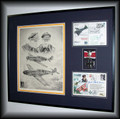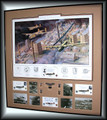 Loading... Please wait...
Loading... Please wait...Categories
Our Newsletter
- Home
- Combat Pilots/Pencil Drawings ~ Free Shipping
- Lt.Col. David Lee "Tex" Hill ~ Free Shipping
Product Description
11 x 14 Print Size ---- Unlimited Print Edition
Col. David Lee “Tex” Hill
AVG/23rd F.G. (18.25)
David Lee "Tex" Hill (July 13, 1915 - October 11, 2007) was a fighter pilot and flying ace in World War II, with later service in Korea. Born in Kwangju, Korea, the son of Presbyterian missionaries, but raised in Texas where he graduated from Austin College in 1938. Hill earned his wings as a U.S. Naval Aviator in 1939 and joined the fleet as a TBD Torpedo bomber pilot before joining a SBD dive bomber squadron aboard USS Ranger. In 1941, he was recruited with other Navy, Army and Marine Corps pilots to join the 1st American Volunteer Group (better known by its later nickname of the Flying Tigers). He learned to fly the P-40 Warhawk in the AVG training program in Burma and did well as a fighter pilot in the 2nd Pursuit Squadron (Panda Bear) as a flight leader and then squadron commander becoming one of the top aces under the tutelage of Claire Chennault. David Lee "Tex" Hill landed his first kills on January 3, 1942 when he downed two Ki-27 Nates over the Japanese airfield at Tak, Thailand. He shot down two more on January 23rd and became an ace on the 24th when he shot down a fighter and a bomber over Rangoon. In March, he succeeded Jack Newkirk as Squadron Leader of the Second Squadron. By the time the AVG was disbanded in the summer of 1942, David "Tex" Hill was a double ace, credited with 12 ¼ victories. On May 7th, 1942, the Japanese Army began building a pontoon bridge across the Salween River, which would allow them to move troops and supplies into China. To stem this tide, 2nd Squadron Leader David Lee "Tex" Hill led a flight of four new P-40Es, bombing and strafing into the mile deep gorge. During the next four days, the AVG pilots flew continuous missions into the gorge, effectively neutralizing the Japanese forces. From that day on, the Japanese never advanced farther than the west bank of the Salween. Claire Chennault would later write of these critical missions, "The American Volunteer Group had staved off China's collapse on the Salween." On Thanksgiving Day 1943, he led a force of 12 B-25s, 10 P-38s, and 8 new P-51 Mustangs from Saichwan, China, on the first strike against Formosa. The Japanese had 100 bombers and 100 fighters located at Shimchiku Airfield, and the bombers were landing as "Tex" Hills force arrived. The enemy managed to get seven fighters airborne, but they were promptly shot down. Forty-two Japanese airplanes were destroyed and 12 more were probably destroyed in the attack. The American force returned home with no casualties. After the deactivation of the Flying Tigers in July 1942, Hill was one of only five Flying Tigers to join its USAAF successor, the USAAF 23rd Fighter Group. He was promoted to major in the Army Air Corps, and activated the 75th Fighter Squadron and later to command the 23rd Fighter Group as a Colonel. Before returning to the states in late 1944, "Tex" Hill and his P-51 Mustang scratched another six Japanese aircraft. It is believed that he was the first to down a Zero with a P-51. Altogether, Hill destroyed 18.25 enemy aircraft. The .25 kills comes from an assist, he and 3 other pilots worked together to shoot down a Japanese Ki-27. In 1944, Hill returned to the U.S. and took command of the 412th Fighter Group, America's first operational jet fighter group flying the Bell YP-59 Airacomet and the Lockheed P-80 Shooting Star. He separated from active service in 1945. Postwar, in July 1946, Hill was asked by Texas Governor Coke Stevenson to activate and accept command of the 58th Wing of the Texas Air National Guard. Hill activated Guard units throughout the Gulf Coast and became the youngest Brigadier General in the history of the Guard. He once again saw combat during the Korean war with the Texas Air Guard. He ended his military career in the Air Force Reserves, retiring as a brigadier general. He holds the Distinguished Service Cross, Silver Star, Distinguished Flying Cross with three Oak Leaf Clusters, Presidential Unit Citation with Oak Leaf Cluster, Chinese Order of the Cloud Banner 4th, 5th and 6th grades, 2-Star Wing Decorations, Chinese Victory Medal, Legion of Merit, and British Distinguished Flying Cross. He was inducted into the National Aviaton Hall of Fame in 1968. In 1999, Hill was inducted into the Texas Aviation Hall of Fame located at the Lone Star Flight Museum in Galveston, Texas. Hill died at the age of ninety-two in Terrell Hills, Texas, of congestive heart failure. More than 2,000 people attended his funeral. He was buried at nearby Fort Sam Houston National Cemetery.
Warranty Information
null








